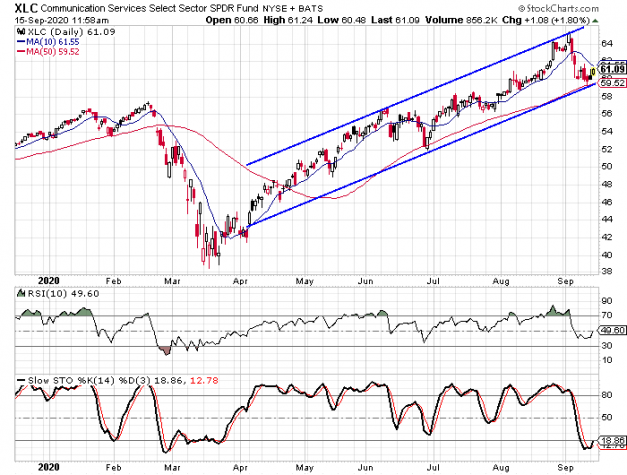When the select sector SPDRs first launched the telecom sector was considered one of the 10 main economic sectors by Standard & Poor’s. However, this was also the time of a huge shift in how people around the world communicate.
The telecom sector alone no longer really captured how the world was communicating. So the developers of the select sector SPDRs in 2007 created a new ETF called the Communication Services Select Sector SPDR (XLC).
The holdings of this ETF reflect the newer forms of communication by including companies such as Alphabet (GOOG) and Facebook (FB).
In fact, of the five largest holdings in the ETF, four of them are FANG stocks. Facebook is the largest holding with 21.5% of the assets. Alphabet Class A shares (GOOGL) represents 11.4% and Alphabet Class C shares (GOOG) represent 11.1% of assets.
Netflix (NFLX) accounts for 4.8% of assets. The lone holding in the top five that isn’t a member of the FANG stocks is T-Mobile US (TMUS). It accounts for 6.5% of the assets in the fund. When you consider those five stocks and their current fundamental ratings, you have a list of five pretty strong companies.
One of the short cuts I have learned in my many years of writing about the market is to use Investor’s Business Daily’s EPS rating and SMR rating to get a snapshot of how a company’s fundamentals compare to other companies. The EPS rating measures earnings growth over the last few years with a heavier weighting on the most recent quarters. The SMR rating measures sales growth, profit margin, and return on equity.
The EPS rating scale ranges from 1 to 99 with 99 being the best. The SMR rating system ranges from “A” to “E” with “A” being the best and “E” being the worst. Looking at the five stocks listed above, all five have EPS ratings over 80, meaning they rank in the top 20th percentile for earnings growth.
On the SMR rating scale, Facebook and Netflix both get “A” ratings while the other three get “B” ratings. Those overall ratings are pretty strong.
The fundamentals are good, but the chart is what got my attention
As good as the overall fundamentals are for the top five holdings in the Communication Services Select Sector SPDR it was the chart that caught my eye. The daily chart shows how the fund has rallied since the March low and how a trend channel has formed since early April.

We see on the chart how the lower rail connects the highs from June and early September and the parallel lower rail connects the lows from the same months.
The pullback over the last couple of weeks brought the fund down in to oversold territory based on the daily stochastic readings. The indicators were at their lowest levels since February before turning higher in the last few days.
The 50-day moving average is right at the same level of the lower rail of the channel and that should make the support level twice as strong. Between those factors and the bullish crossover of the stochastic indicators, this is a pretty solid bullish signal for the Communication Services Select Sector SPDR.
If we look at the span from early April through mid-June, the XLC gained just over 30%. The rally from late June through early September saw the fund gain 25.8%. Based on the length of time and the percentage gains of those rallies, I like the December option series as a way to play this bullish signal. Specifically I like the December 58-strike calls.
With the XLC currently trading at $61.27, these options are trading at $5.90. If the fund rallies 25% it would put the fund at $73.90 based on the recent low. If the fund rallies 30%, the fund would be up to $76.86.
The December 58-strike calls would be worth anywhere from $15.90 to $18.86 based on those targets. This would mean gains between 170% and 220% for investors, based on the current price.


